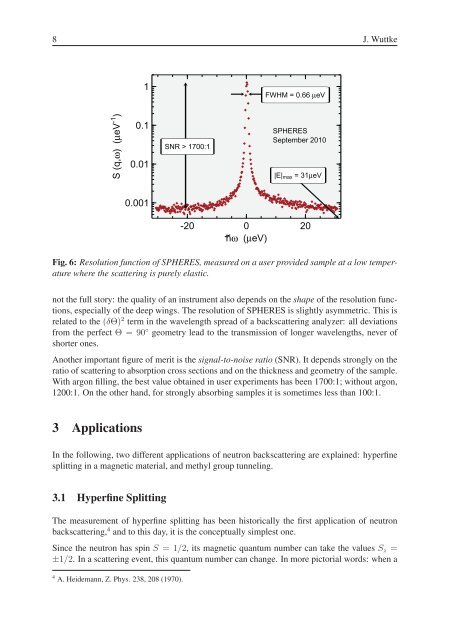Neutron Scattering - JUWEL - Forschungszentrum Jülich
Neutron Scattering - JUWEL - Forschungszentrum Jülich
Neutron Scattering - JUWEL - Forschungszentrum Jülich
Create successful ePaper yourself
Turn your PDF publications into a flip-book with our unique Google optimized e-Paper software.
8 J. Wuttke<br />
S (q,ω) (μeV -1 )<br />
1<br />
0.1<br />
0.01<br />
0.001<br />
SNR > 1700:1<br />
FWHM = 0.66 μeV<br />
SPHERES<br />
September 2010<br />
|E|max = 31μeV<br />
-20 0 20<br />
hω (μeV)<br />
Fig. 6: Resolution function of SPHERES, measured on a user provided sample at a low temperature<br />
where the scattering is purely elastic.<br />
not the full story: the quality of an instrument also depends on the shape of the resolution functions,<br />
especially of the deep wings. The resolution of SPHERES is slightly asymmetric. This is<br />
related to the (δΘ) 2 term in the wavelength spread of a backscattering analyzer: all deviations<br />
from the perfect Θ=90 ◦ geometry lead to the transmission of longer wavelengths, never of<br />
shorter ones.<br />
Another important figure of merit is the signal-to-noise ratio (SNR). It depends strongly on the<br />
ratio of scattering to absorption cross sections and on the thickness and geometry of the sample.<br />
With argon filling, the best value obtained in user experiments has been 1700:1; without argon,<br />
1200:1. On the other hand, for strongly absorbing samples it is sometimes less than 100:1.<br />
3 Applications<br />
In the following, two different applications of neutron backscattering are explained: hyperfine<br />
splitting in a magnetic material, and methyl group tunneling.<br />
3.1 Hyperfine Splitting<br />
The measurement of hyperfine splitting has been historically the first application of neutron<br />
backscattering, 4 and to this day, it is the conceptually simplest one.<br />
Since the neutron has spin S =1/2, its magnetic quantum number can take the values Sz =<br />
±1/2. In a scattering event, this quantum number can change. In more pictorial words: when a<br />
4 A. Heidemann, Z. Phys. 238, 208 (1970).

















